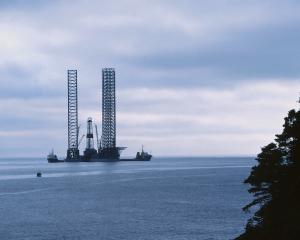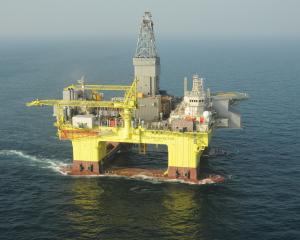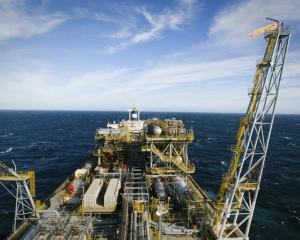A second run of ship-borne seismic data from the Canterbury Basin, understood to be scheduled to be gathered in February and March, has been ordered by Anadarko.
A figure, unconfirmed, of up to $US70 million ($NZ90.5 million) has been suggested by industry sources to relocate a rig to New Zealand, possibly from east Africa, and operate it for up to six weeks in the Canterbury Basin, before its is towed to Taranaki for a drill programme there.
In separate exploration plans in the Great South Basin, Austrian-owned OMV New Zealand remains on track to deliver a "drill or drop" decision by July, as required under its permit conditions.
Three Anadarko staff were in Dunedin in recent weeks, looking at the city as a short-term base for its planned four- to six-week drilling programme at the end of the year, estimated to cost more than $US1 million per day during drilling.
The visit included meetings with Dunedin hospital, Dunedin International Airport, Port Otago, the University of Otago and companies including engineering, provedores, helicopter, maritime and waste management.
Following the second run of seismic data, if a test hole goes ahead, there is potential for up to half of the 100-120 rig crew to be sought from New Zealand. Up to two tender vessels might be required to operated from Port Chalmers during the drilling period.
In February last year Anadarko pledged $US30 million towards its 50% share in a venture with Canterbury Basin permit holder, Australian-listed Origin Energy.
Anadarko's senior staff public affairs representative, Brian Cain, was contacted in Texas and said the company was "very optimistic about the exploration opportunities" in New Zealand and was initiating another ship-borne seismic survey in permitted blocks in both Canterbury and Taranaki.
"Anadarko anticipates being able to drill our first exploration well in the Canterbury Basin as early as the 2011 to 2012 drilling season, and our partnership is about to begin a proprietary 2-D seismic survey to progress exploration on those blocks," Mr Cain said.
Anadarko and Origin want to explore the Carrack and Caravel oil and gas prospects, 65km from Dunedin's coast, which are estimated to potentially contain more than 500 million barrels of oil equivalent.
"Based on the geologic data gathered to date, we believe there's significant potential in both the Canterbury and Taranaki basins. We look forward to evaluating this potential through the drill bit in coming years," Mr Cain said.
Although it was still early in the programme, Anadarko was evaluating options for facilities in New Zealand, to support its deepwater drilling activities here, Mr Cain said.
"Along with other operators, we are considering a rig club arrangement, which would allow participants to fill multiple deepwater well obligations and share mobilisation costs," Mr Cain said.
Industry insiders have said that while the Canterbury Basin visit would be relatively brief, daily costs for operating the rig could be about $US1 million.
It was first mooted Anadarko could possibly share costs of an oil rig with other major companies which were separately considering exploration of the frontier Great South Basin, off the southern coast of the South Island.
However, in early-October last year that multibillion-dollar proposal foundered when cornerstone companies United States giant Exxon Mobil and partner Todd Energy relinquished their permit, citing technical risks and lack of a third partner.
The other consortium which retains its Great South Basin permits, is Austrian-based OMV, through its subsidiary OMV New Zealand Ltd, and has until July to make a decision on drilling in the Great South Basin.
OMV NZ managing director Wayne Kirk was contacted yesterday but could confirm only that the interpretation of recent seismic data collated by the company was complete.
He declined to indicate whether the data was favourable or not, but expected to make an announcement by July, as required by the permit issued by Crown Minerals.
He said OMV had talked to Anadarko in recent months, but when asked if rig-sharing was a possibility, Mr Kirk said OMV was not yet aware of Anadarko's drilling intentions.
At last year's New Zealand Petroleum Conference, OMV called on the Government for a review to allow for initial frontier exploration permits to move from five-year to eight-year time frames due to the remoteness, depths, lack of historical data and higher costs.
The future for southern offshore oil exploration looked relatively bright in mid-2007, considering exploration drilling was last undertaken in the 1970s and '80s when nine holes were drilled, but showed either dry or non-commercial results.
In July 2007, five-year permits for six of a total 40 Great South Basin exploration blocks were awarded to two consortiums; US Exxon Mobil (90%), the world's largest non-government oil company, and Todd Exploration New Zealand (10%).
The OMV New Zealand Ltd consortium includes partners PTTEP Offshore Investment, of Thailand (36%), and Mitsui Exploration and Production Australia, of Japan (28%).
Had exploration drilling by the consortiums gone ahead it was estimated the pair could have spent up to $1.2 billion. Both consortiums have separately run several thousand kilometres of ship-borne seismic testing in the Great South Basin.
• Anadarko was a 25% shareholder in the ill-fated BP-owned Deepwater Horizon oil well in the Gulf of Mexico which exploded in April last year, killing 11 rig crew and releasing an estimated five million barrels of oil into the ocean.




